Question
True/False Multiple Choice 1) A corporation is a separate legal entity that is organized independently of its owners. 2) Stockholders of a corporation are not
True/False Multiple Choice
1) A corporation is a separate legal entity that is organized independently of its owners.
2) Stockholders of a corporation are not personally liable for the corporation's debt.
3) Which of the following corporate characteristics is a disadvantage of a corporation?
A) Stockholders have limited liability.
B) A corporation has a continuous life.
C) There is no mutual agency between the stockholders and the corporation.
D) Earnings of a corporation may be subject to double taxation.
4) Both common and preferred stock carry the same degree of investment risk for the stockholder.
5) Stated value stock is no-par stock that has been assigned an amount similar to par value
6) Retained earnings represents amounts received from stockholders of a corporation in exchange for stock
7) Outstanding stock represents shares of stock that ________.
A) are held by the stockholders
B) are sold for the highest price
C) have been authorized by state law
D) have been issued but may or may not be held by stockholders
8) The par value of stock is ________.
A) the current selling price of stock
B) the highest price for which a share can sell
C) the price paid if the corporation purchases its own stock back
D) the amount assigned by a company to a share of its stock
9) Preferred stock is stock ________.
A) that sells for a high price
B) that is distributed to employees as annual bonuses
C) that is distributed by corporations to avoid liquidation
D) that gives its owners certain advantages over common stockholders
10) Bradley Corporation received cash from issuing 17,000 shares of common stock at par on January 1, 2017. The stock has a par value of $0.05 per share. Which is the correct journal entry to record this transaction?
A) Cash is debited for $850, and Common Stock$0.05 Par Value is credited for $850.
B) Cash is credited for $17,000 and Common Stock$0.05 Par Value is debited for $17,000.
C) Paid-In Capital in Excess of ParCommon is debited for $16,150, and Common Stock$0.05 Par Value is credited for $16,150.
D) Cash is debited for $17,000, Common Stock$0.05 Par Value is credited for $850, and Paid-In Capital in Excess of Par-Common credited for $16,150.
11) When a corporation sells 9,000 shares of $12 par value common stock for $159,000, Common Stock is credited for $108,000. Debit Cash 159,000 Credit Common stock 108,000 Credit Paid in Excess 51,000.
12) Which of the following is included in the entry to record the issuance of 14,000 shares of $7 par value common stock at $21 per share cash?
A) Cash is debited for $294,000.
B) Common Stock is debited for $98,000.
C) Common Stock is credited for $294,000.
D) Paid-In Capital in Excess of ParCommon is debited for $196,000.
13) Dallkin Corporation issued 10,000 shares of common stock on January 1, 2017. The stock has no par value and was issued at $17 per share. The journal entry for this transaction includes a ________.
A) debit to Cash for $170,000 and a credit to Common StockNo-Par Value for $170,000
B) debit to Cash for $170,000 and a credit to Paid-In Capital in Excess of ParCommon for $170,000
C) credit to Cash for $170,000 and a debit to Common StockNo-Par Value for $170,000
D) credit to Cash for $170,000, a debit to Paid-In Capital in Excess of ParCommon for $10,000, and a debit to Common StockNo-Par Value for $160,000
14) Osbourne, Inc. issued 60,000 shares of common stock in exchange for manufacturing equipment. The equipment has a fair value of $1,420,000. The stock has a par value of $0.05 per share. The journal entry to record this transaction includes a ________.
A) debit to Cash for $14,170,000
B) credit to Gain on Sale of Common Stock for $1,480,000
C) credit to Paid-In Capital in Excess of ParCommon for $1,417,000
D) credit to Common Stock$0.05 Par Value for $1,420,000
15) A corporation declares a dividend of $0.50 per share on 18,000 shares of common stock. Which of the following is included in the entry to record the declaration?
A) Cash Dividends is debited for $9,000.
B) Paid-In Capital in Excess of ParCommon is credited for $9,000.
C) Cash Dividends is credited for $9,000.
D) Dividends PayableCommon is debited for $9,000.
16) Dividends in arrears are ________.
A) a liability on the balance sheet
B) passed dividends on noncumulative preferred stock
C) passed dividends on cumulative preferred stock
D) passed dividends on common stock
17) On November 1, 2017, Oster, Inc. declared a dividend of $4.50 per share. Oster, Inc. has 23,000 shares of common stock outstanding and no preferred stock. Which of the following is the journal entry needed to record the declaration of the dividend?
A) Debit Dividends PayableCommon $103,500, and credit Retained Earnings $103,500.
B) Debit Cash Dividends $103,500, and credit Cash $103,500.
C) Debit Cash Dividends $103,500, and credit Dividends PayableCommon $103,500.
D) Debit Cash $103,500, and credit Dividends PayableCommon $103,500.
18) A business's cash receipts and cash payments for a specific period are reported on a(n) ________.
A) income statement
B) balance sheet
C) statement of cash flows
D) cash reconciliation statement
19) The statement of cash flows explains why net income as reported on the income statement does not equal the change in the cash balance.
20) The financing activities section of the statement of cash flows includes paying dividends and making payments on long-term liabilities.
Step by Step Solution
There are 3 Steps involved in it
Step: 1

Get Instant Access to Expert-Tailored Solutions
See step-by-step solutions with expert insights and AI powered tools for academic success
Step: 2

Step: 3

Ace Your Homework with AI
Get the answers you need in no time with our AI-driven, step-by-step assistance
Get Started


